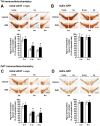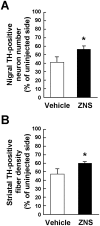Zonisamide attenuates α-synuclein neurotoxicity by an aggregation-independent mechanism in a rat model of familial Parkinson's disease
- PMID: 24586512
- PMCID: PMC3930669
- DOI: 10.1371/journal.pone.0089076
Zonisamide attenuates α-synuclein neurotoxicity by an aggregation-independent mechanism in a rat model of familial Parkinson's disease
Abstract
The anti-epileptic agent zonisamide (ZNS) has been shown to exert protective effects in neurotoxin-based mouse models of Parkinson disease. However, it is unknown whether ZNS can attenuate toxicity of familial Parkinson's disease-causing gene products. In this study, we investigated the effects of ZNS on neurodegeneration induced by expression of A53T α-synuclein in the rat substantia nigra using a recombinant adeno-associated virus vector. Expression of A53T α-synuclein yielded severe loss of nigral dopamine neurons and striatal dopamine nerve terminals from 2 weeks to 4 weeks after viral injection. Oral administration of ZNS (40 mg/kg/day) significantly delayed the pace of degeneration at 4 weeks after viral injection as compared with the vehicle group. This effect lasted until 8 weeks after viral injection, the final point of observation. ZNS treatment had no impact on the survival of nigrostriatal dopamine neurons in rats expressing green fluorescent protein. Quantification of striatal Ser129-phosphorylated α-synuclein-positive aggregates showed that these aggregates rapidly formed from 2 weeks to 4 weeks after viral injection. This increase was closely correlated with loss of nigrostriatal dopamine neurons. However, ZNS treatment failed to alter the number of all striatal Ser129-phosphorylated α-synuclein-positive aggregates, including small dot-like and large round structures. The number of these aggregates was almost constant at 4 weeks and 8 weeks after viral injection, although ZNS persistently prevented loss of nigrostriatal dopamine neurons during this period. Also, ZNS treatment did not affect the number of striatal aggregates larger than 10 µm in diameter. These data show that ZNS attenuates α-synuclein-induced toxicity in a manner that is independent of the formation and maturation of α-synuclein aggregates in an in vivo model of familial Parkinson's disease, suggesting that ZNS may protect nigrostriatal dopamine neurons by modulating cellular damage or a cell death pathway commonly caused by neurotoxins and α-synuclein.
Conflict of interest statement
Figures






Similar articles
-
AAV1/2-induced overexpression of A53T-α-synuclein in the substantia nigra results in degeneration of the nigrostriatal system with Lewy-like pathology and motor impairment: a new mouse model for Parkinson's disease.Acta Neuropathol Commun. 2017 Feb 1;5(1):11. doi: 10.1186/s40478-017-0416-x. Acta Neuropathol Commun. 2017. PMID: 28143577 Free PMC article.
-
GM1 Ganglioside Modifies α-Synuclein Toxicity and is Neuroprotective in a Rat α-Synuclein Model of Parkinson's Disease.Sci Rep. 2019 Jun 10;9(1):8362. doi: 10.1038/s41598-019-42847-x. Sci Rep. 2019. PMID: 31182727 Free PMC article.
-
Depopulation of dense α-synuclein aggregates is associated with rescue of dopamine neuron dysfunction and death in a new Parkinson's disease model.Acta Neuropathol. 2019 Oct;138(4):575-595. doi: 10.1007/s00401-019-02023-x. Epub 2019 May 31. Acta Neuropathol. 2019. PMID: 31165254 Free PMC article.
-
Back and to the Future: From Neurotoxin-Induced to Human Parkinson's Disease Models.Curr Protoc Neurosci. 2020 Mar;91(1):e88. doi: 10.1002/cpns.88. Curr Protoc Neurosci. 2020. PMID: 32049438 Review.
-
Novel therapeutic effects of the anti-convulsant, zonisamide, on Parkinson's disease.Curr Pharm Des. 2004;10(6):687-93. doi: 10.2174/1381612043453180. Curr Pharm Des. 2004. PMID: 14965331 Review.
Cited by
-
Zonisamide for the Treatment of Parkinson Disease: A Current Update.Front Neurosci. 2020 Dec 21;14:574652. doi: 10.3389/fnins.2020.574652. eCollection 2020. Front Neurosci. 2020. PMID: 33408605 Free PMC article. Review.
-
Mechanisms underlying extensive Ser129-phosphorylation in α-synuclein aggregates.Acta Neuropathol Commun. 2017 Jun 15;5(1):48. doi: 10.1186/s40478-017-0452-6. Acta Neuropathol Commun. 2017. PMID: 28619113 Free PMC article.
-
Zonisamide's Efficacy and Safety on Parkinson's Disease and Dementia with Lewy Bodies: A Meta-Analysis and Systematic Review.Biomed Res Int. 2022 Sep 12;2022:4817488. doi: 10.1155/2022/4817488. eCollection 2022. Biomed Res Int. 2022. Retraction in: Biomed Res Int. 2024 Jan 9;2024:9859863. doi: 10.1155/2024/9859863. PMID: 36132085 Free PMC article. Retracted.
-
Neuroinflammation following anti-parkinsonian drugs in early Parkinson's disease: a longitudinal PET study.Sci Rep. 2024 Feb 27;14(1):4708. doi: 10.1038/s41598-024-55233-z. Sci Rep. 2024. PMID: 38409373 Free PMC article. Clinical Trial.
-
A scFv antibody targeting common oligomeric epitope has potential for treating several amyloidoses.Sci Rep. 2016 Nov 8;6:36631. doi: 10.1038/srep36631. Sci Rep. 2016. PMID: 27824125 Free PMC article.
References
-
- Olanow CW, Watts RL, Koller WC (2001) An algorithm (decision tree) for the management of Parkinson’s disease (2001): treatment guidelines. Neurology 56: S1–S88. - PubMed
-
- Olanow CW, Agid Y, Mizuno Y, Albanese A, Bonuccelli U, et al. (2004) Levodopa in the treatment of Parkinson’s disease: current controversies. Mov Disord 19: 997–1005. - PubMed
-
- Olanow CW, Jankovic J (2005) Neuroprotective therapy in Parkinson’s disease and motor complications: a search for a pathogenesis-targeted, disease-modifying strategy. Mov Disord 20 Suppl 11S3–10. - PubMed
-
- Olanow CW, Kieburtz K, Schapira AH (2008) Why have we failed to achieve neuroprotection in Parkinson’s disease? Ann Neurol 64 Suppl 2S101–110. - PubMed
-
- Blum D, Torch S, Lambeng N, Nissou M, Benabid AL, et al. (2001) Molecular pathways involved in the neurotoxicity of 6-OHDA, dopamine and MPTP: contribution to the apoptotic theory in Parkinson’s disease. Prog Neurobiol 65: 135–172. - PubMed
Publication types
MeSH terms
Substances
LinkOut - more resources
Full Text Sources
Other Literature Sources
Medical

